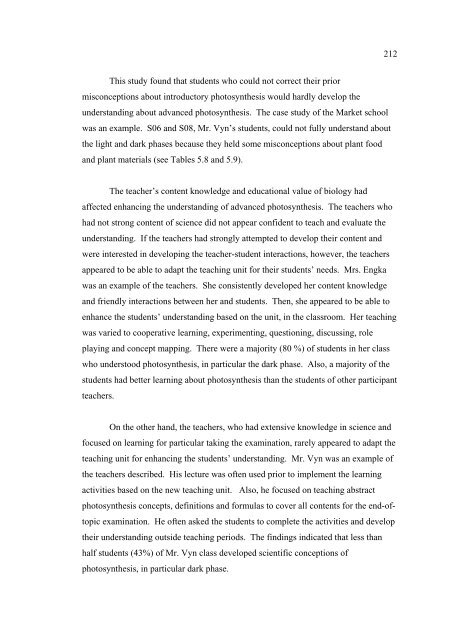an innovative approach
an innovative approach
an innovative approach
Create successful ePaper yourself
Turn your PDF publications into a flip-book with our unique Google optimized e-Paper software.
This study found that students who could not correct their prior<br />
misconceptions about introductory photosynthesis would hardly develop the<br />
underst<strong>an</strong>ding about adv<strong>an</strong>ced photosynthesis. The case study of the Market school<br />
was <strong>an</strong> example. S06 <strong>an</strong>d S08, Mr. Vyn’s students, could not fully underst<strong>an</strong>d about<br />
the light <strong>an</strong>d dark phases because they held some misconceptions about pl<strong>an</strong>t food<br />
<strong>an</strong>d pl<strong>an</strong>t materials (see Tables 5.8 <strong>an</strong>d 5.9).<br />
212<br />
The teacher’s content knowledge <strong>an</strong>d educational value of biology had<br />
affected enh<strong>an</strong>cing the underst<strong>an</strong>ding of adv<strong>an</strong>ced photosynthesis. The teachers who<br />
had not strong content of science did not appear confident to teach <strong>an</strong>d evaluate the<br />
underst<strong>an</strong>ding. If the teachers had strongly attempted to develop their content <strong>an</strong>d<br />
were interested in developing the teacher-student interactions, however, the teachers<br />
appeared to be able to adapt the teaching unit for their students’ needs. Mrs. Engka<br />
was <strong>an</strong> example of the teachers. She consistently developed her content knowledge<br />
<strong>an</strong>d friendly interactions between her <strong>an</strong>d students. Then, she appeared to be able to<br />
enh<strong>an</strong>ce the students’ underst<strong>an</strong>ding based on the unit, in the classroom. Her teaching<br />
was varied to cooperative learning, experimenting, questioning, discussing, role<br />
playing <strong>an</strong>d concept mapping. There were a majority (80 %) of students in her class<br />
who understood photosynthesis, in particular the dark phase. Also, a majority of the<br />
students had better learning about photosynthesis th<strong>an</strong> the students of other particip<strong>an</strong>t<br />
teachers.<br />
On the other h<strong>an</strong>d, the teachers, who had extensive knowledge in science <strong>an</strong>d<br />
focused on learning for particular taking the examination, rarely appeared to adapt the<br />
teaching unit for enh<strong>an</strong>cing the students’ underst<strong>an</strong>ding. Mr. Vyn was <strong>an</strong> example of<br />
the teachers described. His lecture was often used prior to implement the learning<br />
activities based on the new teaching unit. Also, he focused on teaching abstract<br />
photosynthesis concepts, definitions <strong>an</strong>d formulas to cover all contents for the end-oftopic<br />
examination. He often asked the students to complete the activities <strong>an</strong>d develop<br />
their underst<strong>an</strong>ding outside teaching periods. The findings indicated that less th<strong>an</strong><br />
half students (43%) of Mr. Vyn class developed scientific conceptions of<br />
photosynthesis, in particular dark phase.
















